Gallery
- Shiv Mandir, Gharraam, Patiala, Punjab
- Baby Krishna
- Sanjhi Mata Ji
- Effigy of Ravana
- Devi Talaab Mandir Jalandhar City, Punjab
This list of Punjabi Hindu festivals summarizes festivals observed in Punjab. These are based on the Bikrami calendar. [1] The festivals of Maghi and Vaisakhi are determined by the solar aspect and others on its lunar months.[ clarification needed ]
Punjabi Hindus follow the Bikrami calendar to observe religious festivals.
| Major Hindu Punjabi Festival | Date Observed (from year to year dates vary) | Description |
|---|---|---|
| Maghi | January 14 | This festival commemorates Uttarayan and is the Punjabi name for Makara Sankranti. [2] |
| Holi | March/Phalgun Purnima | Spring festival of colours. [3] [4] |
| Rama Navami | Chaitra | Celebrates birth of Lord Rama. [4] [5] |
| Hanuman Jayanti | March/Chaitra Purnima | In honour of Lord Hanuman. [4] |
| Maha Shivratri | Varies, February–March | In honour of Lord Shiva. [6] [7] |
| Vaisakhi | April 13/Vaisakh | Punjabi new year. Falls on Mesha Sankranti. |
| Rakhri | Sawan full moon | Brothers and sisters day. [4] [8] |
| Krishna Janmashtami | Shravana, Krishna Paksha, Ashtami | Celebrates the birth of Lord Krishna. [4] [5] |
| Sanjhi | Varies | To honour the Mother Goddess. [9] |
| Śrāddha | Second half of the month Bhadrapada | Remember ancestors. |
| Navratri | The tenth day of the lunar month Ashwin | To honour the Goddess Durga. [4] [10] |
| Dussehra | the tenth day of the lunar month Ashwin | Celebrated defeat of Ravana by Lord Rama. [4] [11] |
| Diwali | Kartik new moon | Celebrates return of Lord Rama and Sita to Ayodhya. [4] [11] |
| Vishwakarma Puja | Day after Kartik new moon | Reverence to Vishwakarma, the God of architecture. [12] |
| Bhai Dooj known in Punjab/ Jammu as Tikka | Second Day of bright half of Kartik month | Brothers are sisters day celebrated two days after Diwali. [11] |
| Karwa Chauth | Fourth day after Kartik full moon | Women fast for the well being of their husbands and pray to the moon. [4] [13] [ page needed ] |
| Kartik Poornima | Full moon of Kartik | A Fair is held at Ram Tirath Mandir in Amritsar where the sons of Lord Rama, Luv and Kush are believed to have been born. [14] |
In addition to the above, Punjabi Hindus observe other Punjabi festivals such as, Basant Festival of Kites, Lohri, Teej and Gugga.

Holi is a popular and significant Hindu festival celebrated as the Festival of Colours, Love, and Spring. It celebrates the eternal and divine love of the deities Radha and Krishna. Additionally, the day signifies the triumph of good over evil, as it commemorates the victory of Vishnu as Narasimha over Hiranyakashipu. Holi originated and is predominantly celebrated in the Indian subcontinent, but has also spread to other regions of Asia and parts of the Western world through the Indian diaspora.
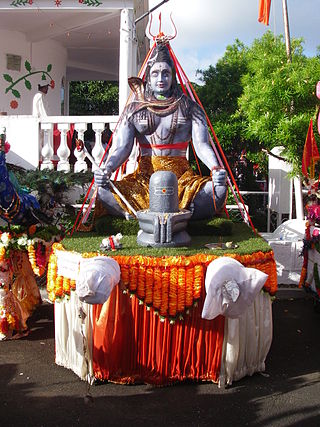
Maha Shivaratri is a Hindu festival celebrated annually in honour of the deity Shiva, between February and March. According to the Hindu calendar, the festival is observed on the fourteenth day of the first half of the lunar month of Phalguna. The festival commemorates the wedding of Shiva and Parvati, and the occasion that Shiva performs his divine dance, called the Tandava.
Śrāvaṇa is the fifth month of the Hindu calendar. In India's national civil calendar, Śrāvaṇa is the fifth month of the year, typically beginning in mid to late July and ending in late August. In the Tamil calendar, it is known as Āadi and is the fifth month of the solar year. In lunar religious calendars, Śrāvaṇa begins on the new moon or the full moon and is the fifth month of the year. Srabon is the fourth month of the solar Bengali calendar. It is also the fourth month of the Nepali calendar. Śrāvaṇa is also the second month of Varsha.
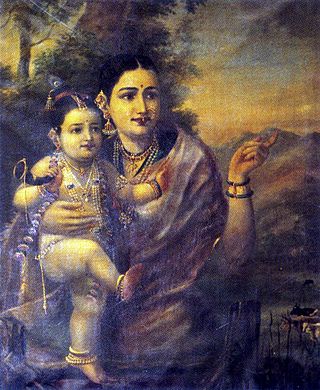
Krishna Janmashtami, also known simply as Krishnashtami, Janmashtami, or Gokulashtami, is an annual Hindu festival that celebrates the birth of Krishna, the eighth avatar of Vishnu. In certain Hindu texts, such as the Gita Govinda, Krishna has been identified as supreme God and the source of all avatars. Krishna's birth is celebrated and observed on the eighth day (Ashtami) of the dark fortnight in Shravana Masa. According to the purnimanta tradition), Krishna's birth is celebrated on the eighth day (Ashtami) of the dark fortnight in Bhadrapada Masa.

Vaisakhi, also known as Baisakhi, marks the first day of the month of Vaisakh and is traditionally celebrated annually on 13 April and sometimes 14 April. It is seen as a spring harvest celebration primarily in Punjab and Northern India. Whilst it is culturally significant as a festival of harvest, in many parts of India, Vaisakhi is also the date for the Indian Solar New Year.

Lohri is a popular winter Dogra and Punjabi folk festival celebrated primarily in Northern India. The significance and legends about the Lohri festival are many and these link the festival to the Duggar region and Punjab region. It is believed by many that the festival marks the passing of the winter solstice. Lohri marks the end of winter, and is a traditional welcome of longer days and the sun's journey to the Northern Hemisphere. It is observed the night before Maghi.
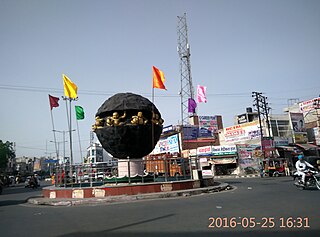
Kaithal is a city and municipal council in the Kaithal district of the Indian state of Haryana. Kaithal was previously a part of Karnal district and later, Kurukshetra district until 1 November 1989, when it became the headquarters of the Kaithal. It shares a border with the Patiala district of state Punjab and the Kurukshetra, Jind and Karnal districts of Haryana. Kaithal district is situated in the North-West of the Haryana state. Its North-West boundaries, which include Guhla-Cheeka are attached to Punjab.
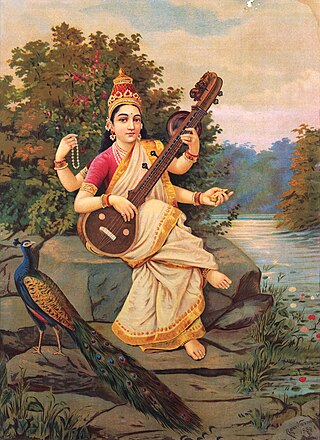
Vasant Panchami, also rendered Vasanta Panchami and Saraswati Puja in honour of the Hindu goddess Saraswati, is a festival that marks the preparation for the arrival of spring. The festival is celebrated in Indian religions in different ways depending on the region. Vasant Panchami also marks the start of preparation for Holika and Holi, which take place forty days later. The Vasant Utsava (festival) on Panchami is celebrated forty days before spring, because any season's transition period is 40 days, and after that, the season comes into full bloom.

Teej, literally meaning the "third" denoting the third day after the new moon when the monsoon begins as per the Hindu calendar, is a combined name for 3 Hindu festivals primarily dedicated to Hindu deities - the mother goddess Parvati and her male consort Shiva, mainly celebrated by married women and unmarried girls mostly in Nepal and North India to wish for the long life of their husband or future husband and to welcome the arrival of monsoon season with the singing, swings, dancing, enjoyment, prayer rituals and often fasting.

Punjabi Hindus are adherents of Hinduism who identify ethnically, linguistically, culturally, and genealogically as Punjabis and are natives of the Punjab region of the Indian subcontinent. Punjabi Hindus are the second-largest religious group of the Punjabi community, after the Punjabi Muslims. While Punjabi Hindus mostly inhabit the Indian state of Punjab, as well as Haryana, Himachal Pradesh, Delhi, and Chandigarh today, many have ancestry across the greater Punjab region, which was partitioned between India and Pakistan in 1947.

Mata Mansa Devi is a Hindu temple dedicated to goddess Mansa Devi, a form of Shakti, in the Panchkula district of the Indian state of Haryana. The temple complex is spread of 100 acres (0.40 km2) of the Shivalik foothills in the village of Bilaspur, near Sector 13 of Chandigarh, and Panchkula, 10 km from Chandi Mandir, another noted Devi shrine in the region, both just outside Chandigarh.

Kartika Purnima, also known as Kartika Pournami, is a Hindu, Sikh, and Jain cultural festival that is celebrated on purnima, the 15th day of the lunar month Kartika. It falls on November or December of the Gregorian calendar and is also known as Tripurari Purnima or Deva-Deepavali, the gods's festival of lights. Karthika Deepam is a related festival that is celebrated in South India and Sri Lanka on a different date. It follows Diwali by about 15 days.

Durgiana Temple or Shri Durgiana Mandir is a Hindu temple situated in the city of Amritsar in Punjab, India. Though a Hindu temple, its architecture is similar to the Sikh Harmandir Sahib. The temple derives its name from the Goddess Durga, the chief Goddess who is worshipped here. Murtis of Lakshmi and Vishnu are also located and worshipped in the temple.

Maghi is the regional name of the Hindu festival of Makar Sankranti celebrated in Punjab, Haryana Jammu division and Himachal Pradesh. In Himachal, the festival is also known as Maghi Saaji or Magha Ra Saza. In Bihar and Nepal it is also referred to as Maghi Parva or Maghi Sankranti. whereas it is known as Maghi Sangrand or Uttarain (Uttarayana) in Jammu and Sakrat in Haryana, Maghi is celebrated on first day of the month of Magh of Hindu Calendar. It follows on the heels of the mid-winter festival of Lohri which is marked by bonfires in North Indian fields and yards. The next morning Hindus see as an auspicious occasion for ritual bathing in ponds and rivers.
Punjabi festivals are various festive celebrations observed by the Punjabis, originating in the Punjab region. The Punjabis are religiously a diverse and that affects the festivals they observe. According to a 2007 estimate, a total of ∼75% percent of the Punjabi population is Muslim, accounting about 90 million people, with 97% of Punjabis who live in Pakistan following Islam, in contrast to the remaining 30 million Punjabi Sikhs and Hindus who predominantly live in India.

The Jammu division is a revenue and administrative division of the Indian-administered Jammu and Kashmir in the disputed Kashmir region. It is bordered by the Kashmir division to the north. It consists of the districts of Jammu, Doda, Kathua, Ramban, Reasi, Kishtwar, Poonch, Rajouri, Udhampur and Samba. Most of the land is hilly or mountainous, including the Pir Panjal Range which separates it from the Kashmir Valley and part of the Great Himalayas in the eastern districts of Doda and Kishtwar. Its principal river is the Chenab.
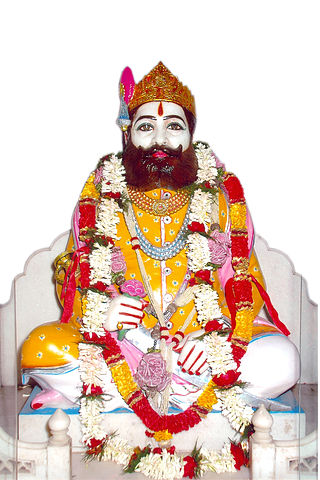
Agrasen Jayanti is the birth anniversary celebration of a legendary Hindu king Agrasen Maharaj. He was king of Agroha, and it was from him that the Agrawal caste originated. Agrasen Jayanti is observed on the fourth day of Ashwin month of Hindu calendar.
The Punjabi calendar is a luni-solar calendar used by the Punjabi people in Punjab and around the world, but varies by religions. Historically, the Punjabi Sikhs and Punjabi Hindus have used the ancient Bikrami (Vikrami) calendar. Punjabi Muslims use the Arabic Hijri calendar alongside the Punjabi Calendar. Some festivals in Punjab, Pakistan are determined by the Punjabi calendar, such as Muharram which is observed twice, once according to the Muslim year and again on the 10th of harh/18th of jeth. The Punjabi calendar is the one the rural (agrarian) population follows in Punjab, Pakistan.
... originally was practised by women in Punjab and parts of UP, is gaining tremendous popularity ...